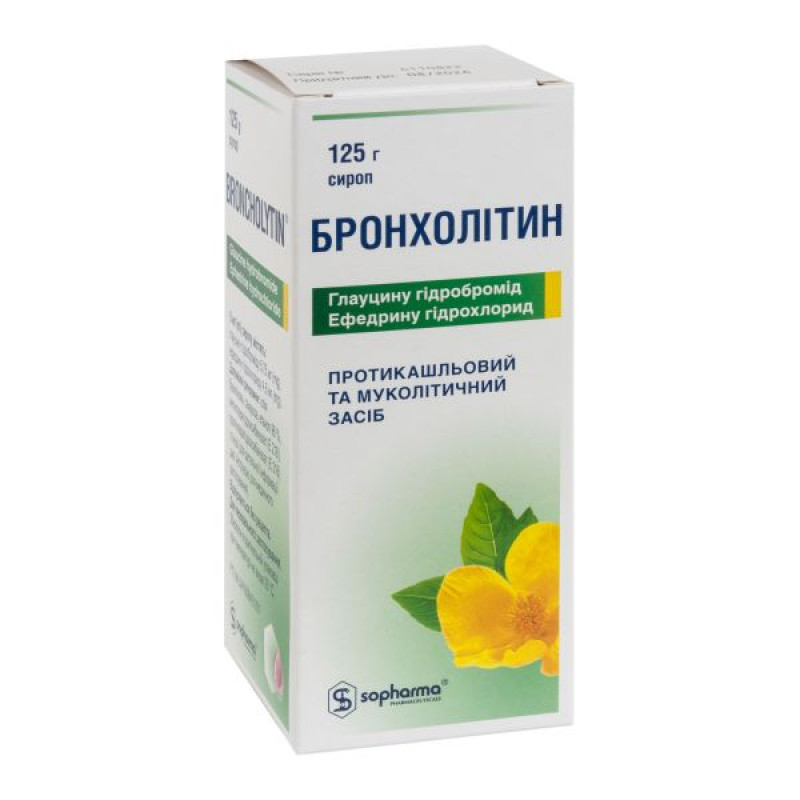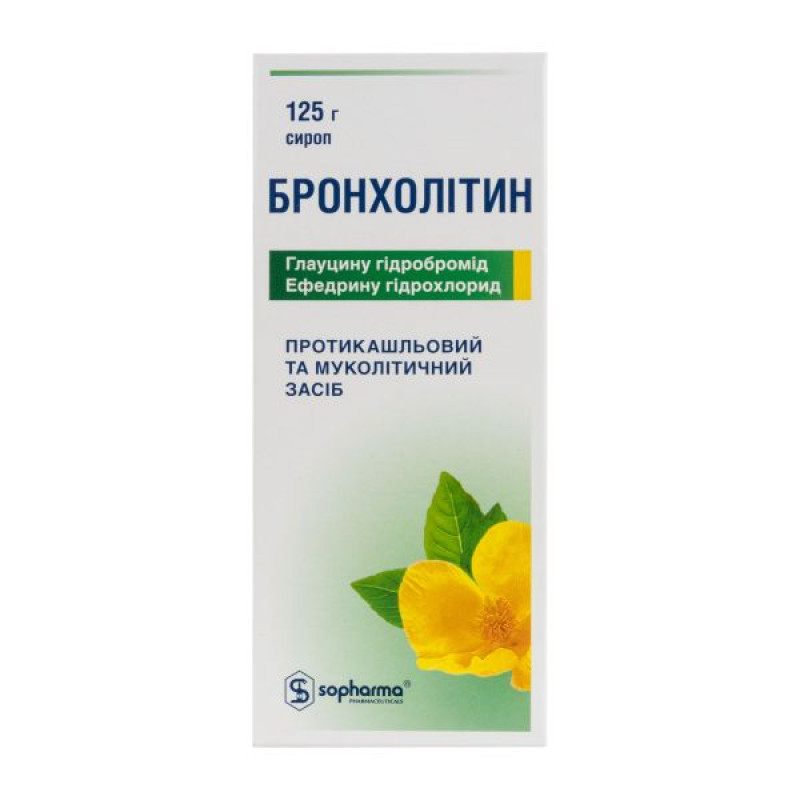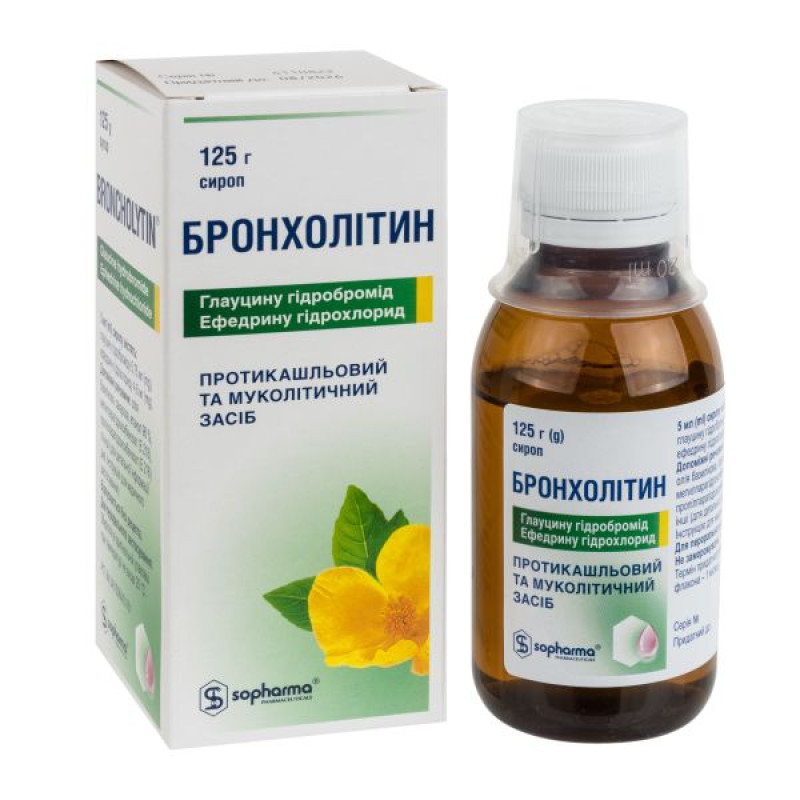Broncholitin syrup bottle 125 g

Instructions Broncholitin syrup bottle 125 g
Composition
active ingredients: 5 ml of syrup contain glaucine hydrobromide 5.75 mg; ephedrine hydrochloride 4.6 mg;
Excipients: basil oil, citric acid monohydrate, sucrose, methyl parahydroxybenzoate (E 218), propyl parahydroxybenzoate (E 216), polysorbate 80, ethanol 96%, purified water.
Dosage form
Syrup.
Main physicochemical properties: syrupy liquid with the smell of basil oil.
Pharmacotherapeutic group
Drugs that act on the respiratory system. Antitussives and mucolytics.
ATX code R05F B01.
Pharmacological properties
Pharmacodynamics
Broncholitin is a combined drug with a pronounced antitussive, bronchodilator and bronchoantiseptic effect. The complex effect of the drug is due to the properties of its main components: glaucine hydrobromide and ephedrine hydrochloride. The alkaloid glaucine suppresses the cough center without affecting the respiratory center. It has a weak bronchospasmolytic and adrenolytic effect, does not cause addiction and dependence. Ephedrine is an adrenomimetic of direct (stimulates alpha and beta receptors) and indirect (inhibits the activity of amino oxidase) action. Causes the release of noradrenaline and adrenaline from their depots. Ephedrine has an antispasmodic effect on the smooth muscles of the bronchi. For a long time, it relaxes the bronchial muscles, which is due to a pronounced stimulating effect on beta-2-adrenoreceptors. Under the influence of ephedrine, swelling of the bronchial mucosa decreases and their lumen expands. Pharmacological studies of Broncholitin syrup show that it reduces the spastic effect of histamine on the bronchi.
Facilitating sputum discharge and bronchial deobstruction are due to the bronchodilating effect of ephedrine.
Pharmacokinetics
After oral administration, glaucine and ephedrine are rapidly and completely absorbed from the gastrointestinal tract.
The maximum concentration of glaucine in blood plasma is reached 1.5 hours after its administration.
Ephedrine is distributed throughout the body, accumulating primarily in the liver, lungs, kidneys, spleen, and brain.
Glaucine and ephedrine (a small part) are metabolized in the liver.
Glaucine is excreted in the urine in the form of metabolites and unchanged.
The half-life of ephedrine is approximately 3-6 hours. It is eliminated in the urine, mainly unchanged.
Indication
As part of the complex therapy of diseases of the respiratory system, which are accompanied by a dry unproductive cough: acute and chronic bronchitis, tracheobronchitis, bronchial asthma, pneumonia, bronchiectasis.
Contraindication
- Hypersensitivity to the active substance or to any of the excipients of the drug.
- Ischemic heart disease.
- Arterial hypertension.
- Acute myocardial infarction.
- Severe organic heart disease with manifestations of decompensation.
- Thyrotoxicosis.
- Pheochromocytoma.
- Angle-closure glaucoma.
- Prostatic hypertrophy with urinary retention.
- Insomnia.
Interaction with other medicinal products and other types of interactions
Broncholitin can be used simultaneously with antibiotics, antipyretics and vitamins. It weakens the effects of narcotic and hypnotic drugs due to the presence of ephedrine in the composition of the drug. When used simultaneously with cardiac glycosides, some sympathomimetics, quinidine, tricyclic antidepressants, the risk of developing arrhythmias increases. When used simultaneously with reserpine and monoamine oxidase inhibitors, a sharp increase in blood pressure is possible.
Since ephedrine has both alpha-agonist and beta-agonist properties, it should be used with caution in patients who have undergone anesthesia with cyclopropane, halothane,
or other volatile anesthetics.
Ergot alkaloids and oxytocin potentiate the pressor effect of ephedrine (risk of hypertensive crisis with simultaneous use).
When used simultaneously with non-selective beta-blockers, the bronchodilator effect of the product is reduced.
Sympathomimetics have an antagonistic effect on the antihypertensive effect of beta-blockers.
Ephedrine may counteract the neuron-blocking effect of guanethidine, leading to a loss of its hypotensive efficacy.
Ephedrine accelerates the metabolism of dexamethasone.
With simultaneous treatment with Broncholitin and oral antidiabetic drugs, a decrease in their hypoglycemic effect is possible.
The drug should not be used simultaneously with cough suppressants, both central (codeine, codterpin) and peripheral (exangit, libexin) mechanisms of action. Unjustified combination with drugs that lead to a decrease in bronchial secretion (for example, atropine derivatives).
Other drugs that stimulate the central nervous system (CNS) or tonic drinks of herbal origin (coffee, tea, Coca-Cola) may enhance the stimulating effects of Broncholitin on the CNS when used simultaneously.
Application features
Due to the stimulating effect on the CNS and possible sleep disturbance, taking Broncholitin syrup after 4 p.m. is not recommended.
If symptoms persist or worsen 5-7 days after the start of treatment, you should consult a doctor to assess the feasibility of further treatment.
Cardiovascular effects may occur with sympathomimetics, including Broncholytin. Postmarketing and literature data have reported rare cases of myocardial ischemia associated with beta-agonists (ephedrine hydrochloride). Patients with cardiac disease (arrhythmia) using this drug should be advised to seek medical attention if chest pain or other symptoms of worsening cardiac disease occur. Special attention should be paid to the evaluation of symptoms such as dyspnea and chest pain, as they may be of both respiratory and cardiac origin.
Glaucine hydrobromide should not be used in productive coughs accompanied by sputum production, as there is a risk of bronchial obstruction due to bronchial secretion retention. In case of labile blood pressure, a doctor's consultation is necessary. Use with caution due to the risk of collapse as a result of the sympatholytic effect of glaucine hydrobromide.
Broncholitin contains 43.75 g of sucrose. When used in recommended doses, each dose (5 ml) contains up to 2 g of sucrose. People with known intolerance to some sugars should consult their doctor before taking this medicinal product. The product may be harmful to the teeth.
Broncholitin contains up to 1.7 vol.% ethanol. Each dose (5 ml) contains up to 0.069 g of alcohol. This is dangerous for patients with liver disease, alcoholism, epilepsy, and brain diseases.
The syrup contains methyl and propyl parahydroxybenzoate as excipients, which may cause allergic reactions (possibly delayed).
The content of ephedrine in the product may give a positive result in a doping test in athletes.
Use during pregnancy or breastfeeding
Do not use in the first trimester of pregnancy or during breastfeeding.
There are no data on the safety of use during the second trimester, so it is recommended to use only in cases where the benefit to the mother outweighs the potential risk to the fetus.
If ephedrine is used during the last trimester, it may cause an increase in the fetal heart rate.
Ability to influence reaction speed when driving vehicles or other mechanisms
The drug should be used with caution when driving or operating automated machinery due to the action of ephedrine. Ephedrine may cause mydriasis and affect the speed of reaction when driving or operating machinery.
Method of administration and doses
Administer orally after meals.
Adults and children over 10 years of age: 10 ml 3-4 times a day.
Children: aged 3 to 5 years – 5 ml of the drug, diluted immediately before use in 10 ml of cooled boiled water, 3 times a day;
aged 5 to 10 years – 5 ml 3 times a day.
The duration of the treatment course is 5-7 days.
Children
Recommended for children aged 3 and up.
Overdose
Overdose may cause nausea, vomiting, loss of appetite, nervous excitement, tremor of the limbs, dizziness, increased sweating, difficulty urinating, increased blood pressure, decreased blood pressure, headache, drowsiness, weakness, rapid fatigue, increased manifestations of adverse reactions, paranoid psychosis, delusions, hallucinations.
Treatment: gastric lavage, use of activated charcoal and symptomatic treatment.
Adverse reactions
When using the drug Broncholitin, the following undesirable reactions may occur:
from the cardiovascular system: disturbances of heart rhythm and conduction, tachycardia, extrasystole, increased blood pressure, myocardial ischemia, circulatory disorders in the extremities;
from the nervous system: tremor, agitation, anxiety, restlessness, insomnia, dizziness;
from the digestive system: anorexia, nausea, vomiting, constipation;
Urinary system: difficulty urinating, urinary retention is possible in patients with prostatic hypertrophy;
Skin and mucous membranes: skin rashes, itching, hives, increased sweating;
from the sensory organs: visual impairment;
others: dry mouth, shortness of breath, weakness, increased libido, dysmenorrhea, tachyphylaxis, hypersensitivity reactions, bronchospasm, angioedema.
Expiration date
4 years.
The shelf life after opening the bottle is 1 month.
Storage conditions
Keep out of reach of children. Store in original packaging at a temperature not exceeding 25 ºС. Do not freeze!
Packaging
Syrup 125 g in bottles (125 ml capacity) made of glass or polyethylene terephthalate (PET). Glass bottles are closed with aluminum or polyethylene caps, PET bottles are closed with polyethylene caps.
1 bottle with a measuring cup in a cardboard pack.
Vacation category
Without a prescription.
Producer
Location of the manufacturer and its business address
JSC "Sopharma".
16 Ilienskoe Shose St., Sofia, 1220, Bulgaria.
There are no reviews for this product.
There are no reviews for this product, be the first to leave your review.
No questions about this product, be the first and ask your question.


















